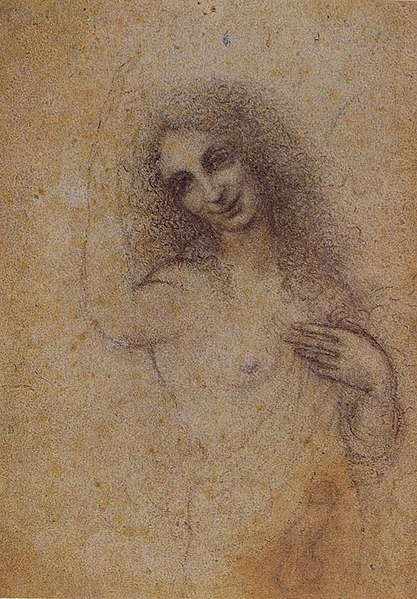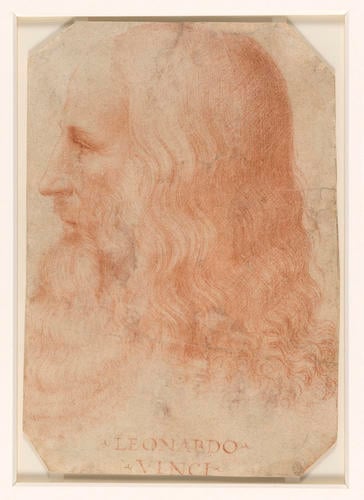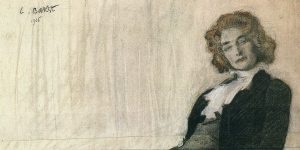Leonardo da Vinci’s queer life: Taken out of the picture
By: J. R. Hirst

There are two men missing at the Château du Clos Lucé.
The Château, which is really just a large red brick house, is in France’s Loire Valley. The missing men are not French however, they are Italian.
The Château du Clos Lucé is where Leonardo da Vinci spent the last years of his life, from 1516 to 1519. By all historical reports, he was happy there.
Da Vinci lived at the Château as a guest of the king of France, François I. The king called da Vinci ‘father’, and apparently loved to listen to him talk. He had gardens to walk in and a workshop in which to paint the masterpieces he brought with him from Italy, including the Mona Lisa. (It is astonishing to think that a painting that is now protected by bulletproof glass was once carried on the back of a mule through the Alps.)
When you visit the Château, you can still see the workshop. You’ll also see where da Vinci worked on designs for his machines, and where he studied nature. The garden where da Vinci once held parties is now full of replicas of his designs.
The whole museum is a loving homage to this great man. Many rooms explore his ideas – what he thought and what interested him.
This year at Easter, I visited the Château with the man I plan to marry. We wandered through the rooms together. He delighted in the machines da Vinci designed, while I was drawn to the paintings.
While growing up in Australia in the 1970s, I covered the walls of my bedroom with reproductions of paintings that I cut out from magazines and books. I knew this made me the weird kid; all the other boys were outside throwing balls around.
But art fascinated me – with its sense of escaping into another world, and the way reality could be shifted and changed. I remember staring at sketches da Vinci made for paintings like St Anne and the Virgin and St John the Baptist. Who were these strange otherworldly people with enigmatic smiles? And why did they fascinate me?
I didn’t know then that the model for St John the Baptist was actually da Vinci’s muse and lover.
Gian Giacomo Caprotti was Leonardo da Vinci’s companion for 25 years.
He was the model for many of da Vinci’s paintings, including St John the Baptist, where you see him smiling playfully for the painter. By all accounts, Caprotti both infuriated and captivated the older man. Da Vinci nicknamed him ‘Salai’, meaning ‘little devil’, for his habit of stealing things, lying and playing pranks.
Yet Leonardo loved him enough to buy him expensive clothes, and he desired him enough to depict him in Angelo Incarnato, naked, with an erection and the same flirtatious smile on his face.
A second companion of da Vinci’s was Francesco Melzi. Like Salai, Melzi was an apprentice of da Vinci.
He remained with him in the Château until da Vinci’s death. In a letter Melzi wrote, he called Leonardo’s love towards him “a deeply passionate and most burning love”.
Da Vinci left Melzi almost everything when he died. It is thanks to Francesco Melzi that we still have copious amounts of da Vinci’s drawings and designs that he inherited and valued enough to categorise.
Melzi is said to have been devoted to the older man, a devotion you can see in the portrait he did of Leonardo.
Most scholars believe that both Salai and Melzi lived with da Vinci while in sexual relationships with him.
This kind of queer intimacy between older and younger men was so common in Florence during da Vinci’s life, that the Germans coined the term ‘Florenzer’ to refer to same-sex relationships.
And yet, you will find very little mention of them at the Château. Melzi is referred to briefly as a disciple, and never mentioned again. I could find no mention of Salai at all.
I couldn’t help but wonder: if Salai were a woman, would she be called his muse, and have many pages dedicated to her and the impact she had on his work and life? Why is it different because he was a man?
My partner and I were part of a large crowd stepping dutifully from one room to the next. We saw the room where he ate, the rooms where he worked, as well as his red four-poster bed.
The rooms were full of the chatter of visitors, and yet standing there looking at it all, I felt a strange silence.
I remembered my own bad old days, when my partner was introduced by others as my ‘friend’, or left out of group family photos. I thought of my friend P, whose father came to stay and refused to speak to her female partner. I thought of a man I know who can’t put photos of his boyfriend on Facebook, because his parents don’t want their relatives to know about him.
I heard that little voice inside me, the one that says: Nobody wants to hear your story. Nobody really cares about people like you.
As I stood there with the man I plan to marry, I thought back to that teenager covering his walls with paintings. I think he would have felt a lot less alone if he had known about this side of da Vinci’s life.
In the Château’s kitchen, we read that Leonardo liked to sit and talk to the cook, to whom he bequeathed his velvet cloak. Details like this add to our understanding of the man and make him more human.
But there’s no mention of where he sat with Melzi, to whom he gave almost the entirety of his estate. There is no mention of Melzi or Salai in the workrooms, where they would have spent most of their days helping the master.
There’s no mention of the portraits that Melzi made of Leonardo, or the many paintings and drawings that Leonardo did of Salai. It’s as if these two men did not exist; their presence in the house was ghostlike, invisible. They were there, but could not be seen.
Right here, in this room and on this bed, Leonardo da Vinci lay with Salai and Francesco Melzi. In the dining room, they ate together, told stories and made each other smile. Five hundred years later, they have both been written out of the museum that stands in the place they lived.
I stood with my partner, and felt that we too were somehow silenced. I thought of how many LGBTIQ+ lives and relationships are airbrushed out of history.
I thought of the deliberate silence around our existence, and the arduous lengths we have to go to just to defend ourselves, or prove that we exist.
Da Vinci was charged with sodomy when he was 23, which must have been traumatising for him. Unfortunately his experience of being erased and punished is all too typical for people like us.
Nobody knows why Salai left and returned to Milan a year before da Vinci died. Perhaps they argued, since he received very little in the will. Perhaps there was jealousy between him and Melzi, or competition for Leonardo’s attention.
But I hope that they were happy for the many years they were together. I hope that Salai made him laugh and gave him pleasure, and that he was worth the expensive clothes. I like to think that he really was as beautiful as they say.
Later, my partner and I stepped outside into the large gardens of the Château.
Children ran around the lake and under the trees, and people stopped to turn the wheels of the machines lovingly recreated from da Vinci’s designs. There was a screw that drew water out of the river and a removable bridge.
Some of his more famous paintings hung from the trees and moved slowly in the breeze: androgynous faces with enigmatic smiles.
Ahead of us in the garden, two men walked, holding hands. As they walked, the older man tickled the palm of his lover.
We watched them move away under the trees, laughing.
J. R. Hirst is an Australian writer living in Barcelona. He has been published in Barcelona Metropolitan, Right Now and Nscribe. His short story The Anti Novelists was shortlisted for the Peter Carey Award in 2017. He is working on his second novel, a coming of age queer romance set in Australia in the 1980s.

















Fantastic I really enjoyed the work.